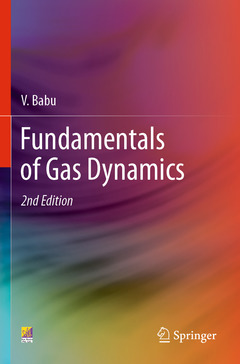Description
Fundamentals of Gas Dynamics (2nd Ed., 2nd ed. 2021)
Author: Babu V.
Language: English
Subjects for Fundamentals of Gas Dynamics:
Keywords
Gas Dynamics; Normal Shock; Fanno Flow; Rayleigh flow; Prandtl Meyer flow
Fundamentals of Gas Dynamics
Publication date: 11-2021
195 p. · 15.5x23.5 cm · Paperback
Publication date: 11-2021
195 p. · 15.5x23.5 cm · Paperback
Fundamentals of Gas Dynamics
Publication date: 11-2020
195 p. · 15.5x23.5 cm · Hardback
Publication date: 11-2020
195 p. · 15.5x23.5 cm · Hardback
Description
/li>Contents
/li>Biography
/li>Comment
/li>
Introduction.- One Dimensional Flows - Basics.- Normal Shock Waves.- Flow with Heat Addition- Rayleigh Flow.- Flow with Friction - Fanno Flow.- Quasi One Dimensional Flows.- Oblique Shock Waves.- Prandtl Meyer Flow.- Flow of Steam through Nozzles.
Dr. V. Babu is currently Professor in the Department of Mechanical Engineering at IIT Madras, Chennai. He received his B.E. in Mechanical Engineering from REC Trichy in 1985 and Ph.D. from Ohio State University in 1991. He worked as a Post-Doctoral researcher at the Ohio State University from 1991 to 1995. He was a Technical Specialist at the Ford Scientific Research Lab, Michigan from 1995 to 1998. He received the Henry Ford Technology Award in 1998 for the development and deployment of a virtual wind tunnel. He has four U.S. patents to his credit. He has published technical papers on simulations of fluid flows including plasmas and non-equilibrium flows, computational aerodynamics and aeroacoustics, scientific computing and ramjet, scramjet engines. His primary research specialization is CFD and he is currently involved in the simulation of high speed reacting flows, prediction of jet noise, simulation of fluid flows using the lattice Boltzmann method and high performance computing.
Motivation for concepts is drawn from practical applications Development of the concepts follows class-room tested pedagogy Worked examples and end of chapter problems are all related to practical applications
© 2024 LAVOISIER S.A.S.
These books may interest you

Fundamentals of Gas Dynamics 93.20 €

High Enthalpy Gas Dynamics 127.72 €


